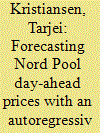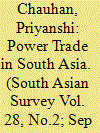| Srl | Item |
| 1 |
ID:
115659


|
|
|
|
|
| Publication |
2012.
|
| Summary/Abstract |
This paper presents a model to forecast Nord Pool hourly day-ahead prices. The model is based on Weron and Misiorek (2008) but reduced in terms of estimation parameters (from 24 sets to 1) and modified to include Nordic demand and Danish wind power as exogenous variables. We model prices across all hours in the analysis period rather than across each single hour of 24 hours. By applying three model variants on Nord Pool data, we achieve a weekly mean absolute percentage error (WMAE) of around 6-7% and an hourly mean absolute percentage error (MAPE) ranging from 8% to 11%. Out of sample results yields a WMAE and an hourly MAPE of around 5%. The models enable analysts and traders to forecast hourly day-ahead prices accurately. Moreover, the models are relatively straightforward and user-friendly to implement. They can be set up in any trading organization.
|
|
|
|
|
|
|
|
|
|
|
|
|
|
|
|
| 2 |
ID:
180252


|
|
|
|
|
| Summary/Abstract |
South Asia is the fastest growing region in the world and is experiencing increasing demand for energy. As a result, countries are witnessing an excessive reliance on fuel imports, making themselves vulnerable to external price volatility and compromising on energy security. Power trade in South Asia can meet the challenge of increasing energy demand owing to complementarities in resource endowments and peak demand. Power trade in South Asia has increased over the years but is below potential. However, there are various challenges due to lack of institutional structures and frameworks for developing regional power trade models. The examples of power integration models in Europe, that is, the Nordic power market, and in Southeast Asia, that is, power trade in the Greater Mekong Subregion (GMS), can provide useful lessons and international best practices for regional power trade to be replicated in the South Asian context. Based on this, the objective of this article is to evaluate the existing power trading mechanisms in South Asia, highlight the challenges to regional energy cooperation, outline the necessary instruments and catalysts to promote regional power trade in South Asia based on the case study of successful power trading arrangements, including the Nordic power market in Europe and the Greater Mekong Subregion (GMS) in Southeast Asia, draw on their experiences to identify key mechanisms and develop a template for greater regional cooperation in electricity in South Asia.
|
|
|
|
|
|
|
|
|
|
|
|
|
|
|
|